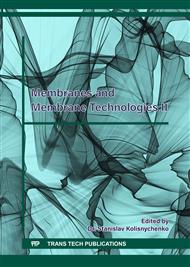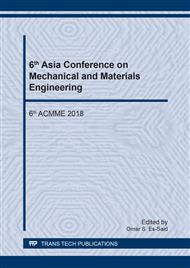p.147
p.154
p.159
p.165
p.170
p.176
p.181
p.189
p.194
Microporous Aluminum Fumarate (A520) Metal-Organic Framework as Modifier to Free-Standing Mixed Matrix Membrane
Abstract:
Microporous aluminum fumarate (A520) is one of the very few metal-organic frameworks (MOFs) that have been promoted to the level of commercial applications and has recently been proven to exhibit a rigid character with an accessible permanent porosity. This study explored the maximum loading amount of A520 for mixed matrix membrane (MMM) preparation by blending it with polyimide (PI) using N-methylpyrrolidone (NMP) as solvent, without compromising the membrane integrity. Scanning electron microscope (SEM) images revealed that MOFs were able to infiltrate the pores and structures of the polymer, improving the interface and mechanical properties of the polymer, as supported by different characterizations like dynamic mechanical analysis (DMA), x-ray diffraction (XRD), and positron annihilation lifetime spectroscopy (PALS). Results showed that MOF loading beyond 10wt% revealed aggregations that compromised the integrity of the membrane.
Info:
Periodical:
Pages:
170-175
Citation:
Online since:
October 2018
Keywords:
Price:
Сopyright:
© 2018 Trans Tech Publications Ltd. All Rights Reserved
Share:
Citation:



